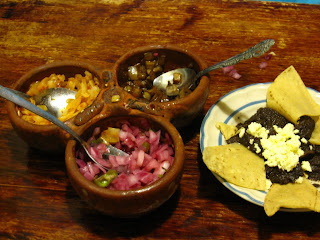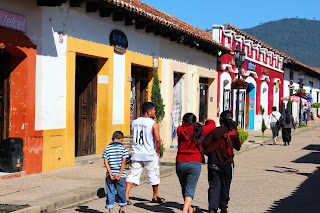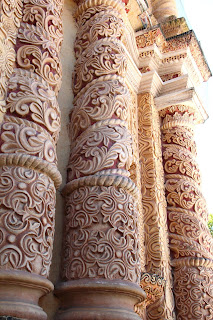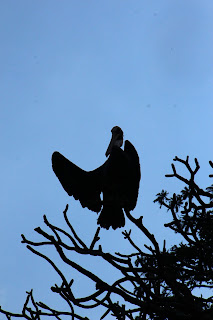** Part 3: Mexico (east & south) **
**Introducing Mexico**
Mexico is about 6 times the size of Malaysia, with a population of 118 millions. The 13th largest country by area in the World and the 11th most populous. A big country by any standard. It is of upper middle-income, per capital GDP around US$ 15,800, the 15th largest economy in the World. Electronics is the key export, around 30%.
It is an ecologically megadiverse country, ranked within the top 5 in the World for its biodiversity. Due to its diverse culture and history, Mexico has 35 UNESCO World Heritage sites, the most number of any country in the Americas and 7th in the World. 35 million international tourists visit Mexico per year.
The people
60% Mestizo (mixed ancestry), 19% Whites, 15% indigenous. The indigenous people belong to many groups: Mayan, Mixtec, Xapotec, etc . Religion wise, 83% Catholics and 9% Protestants. Spanish is the national language.
Places covered
We started at the eastern end, came to the southern states with more indigenous people, and ended our tour at Mexico City in the central highlands, just a small part of the big country.
The food
The staple foods of the locals are corn and wheat. Rice is rare. The corn or wheat flour will be made into thin flatbread called tortilla, just like our familiar roti canai. A meal is named depending on how the tortilla is served with other toppings or the way it is served. A common meal which we have taken most on this trip is the simple tostada where the roti canai is served with toasted ingredients, usually beef plus vege plus gravy.
The Day of the Death
As in Guatemala the Day of the Death is widely celebrated, 1st and 2nd November. Our second period of visit in Mexico started on November the 3rd. No more active celebration but decorations were still intact in many places. In Mexico skull masks and papier mache painted with skeletons are the most common public decorations.
Shown some interesting items. The 1st and 2nd photos show the papier mache skeleton family and paper-cut lace at our hotel in San Cristobal de las Casas. The 3rd a pair of “girls” found at the Zapotec ruins at Mitla. The 4th a sea of special "laces" at the Templo de la Merced (a church) in San Cristobal. A coffin was on display at a park called the Centro de San Angel in Mexico City. So was a giant skeleton. The last is a very popular skull called “La Calavera Catrina” based on the itched image by the famous engraver Jose Guadalupe Posada in 1910/1913.
**The East and South**
Merida
Merida is the capital of the state of Yucatan at the eastern part of Mexico, with a population near to a million. 60% Mayans, making it the city with the highest % of indigenous people in Mexico. The landmark is the Plaza Grande with some historical buildings, such as the Casa de Montejo built in the 1540s as the palace of the first governors. The original portico shows 2 conquistadors standing triumphantly on the heads of Mayan Indians. Very bad taste indeed! Where are the human rights people? The 2nd series show the City Hall, day and night.
Other notable buildings fronting the square are the Cathedral de San Ildefonso, the oldest church built in the Americas, constructed around 1560-1587 and the Palacio de Gobierno famous for its giant murals painted by Fernado Castro Pacheco in the 1970s. Shown a mural in the old palace, this one about the Caste War between the Mayans and the whites.
Chichen Itza
Chichen Itza is a huge archaeological site about 125 km east of Merida. The city is estimated to have a population of some 35,000 at its peak. It is a relatively new city, active from around 600 to 1200 AD.
We visited only the Great Northern Platform of the vast site. The main attraction is the pyramid called El Castillo, 24 m high and dedicated to Kukulcan, a feathered serpent deity, the Mayan version of Aztec’s God Quetzalcoatl. Its height and striking geometry dominate the site. Below the base was an older temple where the pyramid was built, a practice common in history.
The acoustic is amazing. A clap of the hands in front of the staircase of the pyramid will be followed by an echo that resembles the chirp of a bird, the quetzal, a large colourful bird found in the highlands of Mesoamerica. Yes, a clap becomes a chirp. True, we tried that ourselves.
The 1st photo below shows part of Temple of the Eagles and Jaguars.
Chichen Itza also has the biggest ball court in Mesoamerica, 165 m long. The ball court is a stadium lah. Still in place are 2 engraved rings that the ball has to pass through to win a point. The rubber ball was as big as a man’s head. The ball game played by the Mayans also had ritual significance. The losing team members could be executed, the story shown by carvings on the walls of the court. Our LCW should feel lucky, still alive after having lost in 2 Olympic finals.
Chechen Itza, a UNESCO World Heritage Site, is the 2nd most visited archaeological site in Mexico. In a 2007 worldwide internet poll, the El Castillo was voted as one of the New Seven Wonders of the World. To me it is hugely over-rated. It has received favourable voting because its name sounded like “chicken pizza”. Many people love pizza. And many more love chickens.
Palenque
Palenque is another famous Mayan ruin, located in south Mexico, also a UNESCO World Heritage Site. It is smaller than Chichen Itza but much older, around 200 BC to 800 AD. It was conquered by jungle after that. The main structures which have been recovered from the jungle include the palace and several temples. The most impressive is the Temple of the Inscriptions, constructed during the reign of King Pacal (615-683 AD). His tomb was also there. The pyramid measures about 60 m by 42 m at the base and is 27 m high. At the top the stone temple itself is another 11.4 m in height. The temple is featured on the cover of the Lonely Planet guidebook on Mexico. Wow! On the cover of the best-selling travel guide. Do I need to say more about the grandeur of the temple?
Shown the main palace which is a group of structures and courtyards at the center of the city, a carved image of King Pacal on the palace wall, and the Temple of the Foliated Cross, with a 3-year-old tourist from Beijing, China. We asked this little cutie any difficulty in climbing the steps, she replied, “mei wen ti 没问题” or “no problem”.
San Cristobal de las Casas
San Cristobal is a small town of around 140,000 people in the central highlands of the state of Chiapas in south Mexico. Mostly single story buildings as the town is earthquake prone
There are many churches here. Shown the Cathedral, the architecture has European Baroque, Moorish and indigenous elements. The main façade was completed in 1721.
The Santo Domingo Church is extremely ornate in decoration. The columns and external walls are heavily decorated with stucco.
Canon del Sumidero
The canyon is about 45 km north-west of San Cristobal de las Casas. We had a 2-hour boat ride on the Grijalva River to look at the canyon. It is about 14 km long and nearly I km deep. It supports a variety of wildlife like crocodiles, iguanas, monkeys and several kinds of birds. It is featured in one of Mexico’s currency notes.
The river is heavily populated. The most obvious pollution is garbage, particularly plastic containers. We went there early morning and our boat was the first to start. At a particular spot on the river, where the flow was slowest, over may be a 25 m section, the river was choked with garbage. Like the garbage pieces all cuddled together for warmth in the cold morning. On our way back there was no more such gathering, as the many boats had dispersed them. Only the early tourists see such spectacle!
Monte Alban
Monte Alban is the ruin of the greatest Zapotec city. The top of the mountain was leveled for the creation of the city center. The civilization covered a lengthy period from around 500 BC to 750 AD. The restored areas are the Grand Plaza and the surrounding buildings. Shown the huge Grand Plaza, 200 m by 300 m as viewed from the North Platform, and the central temples.
Monte Albán is special in having a large number of carved stone "Danzantes" (dancers), which represent naked men in contorted and twisted poses, some of them genitally mutilated. Shown 2 dancer carvings and a fellow visitor. People with artificial legs also climbs up and down the ruins, while some able-body visitors just sit at the café to avoid the blazing sun. Also 3 statues in the museum,
Mitla
Mitla is a Zapotec ruin some 44 km north of Oaxaca, also a UNESCO World Heritage Site. While Monte Alban was a political center to the Zapotecs, Mitla was the religious center. The unique feature here is the intricate mosaic fretwork made of small stone tiles. Thousands of pieces of cut and polished stones are fitted without the use of mortar. Shown details of such fretwork. Next to the ruins is a modern church with red domes.
Oaxaca
It is a city with some 265,000 people, the capital of the state of the same name in southern Mexico. The old city is a UNESCO World Heritage Site for its archaeological ruins and the native Zapotec and Mixtec cultures. Shown the famous Church of Santo Domingo, built around 1555 to 1666, and some exhibits on contemporary arts (theme: chairs) in the Santo Domingo Cultural Center.
Big ones around Oaxaca
We also visited a nearby town Santa Maria del Tule to admire the “Tule” tree said to be the World’s largest cypress tree. The diameter is about 12 meters. At least 2,000 years old, as chronicled by the Aztecs, sacred of course. The tree is still growing. This region is rather dry, shown some giant cactus. The giant "pineapples" are in fact the trunks of the mezcal maguey plant, used to make an alcoholic drink called "mezcal".








































































No comments:
Post a Comment